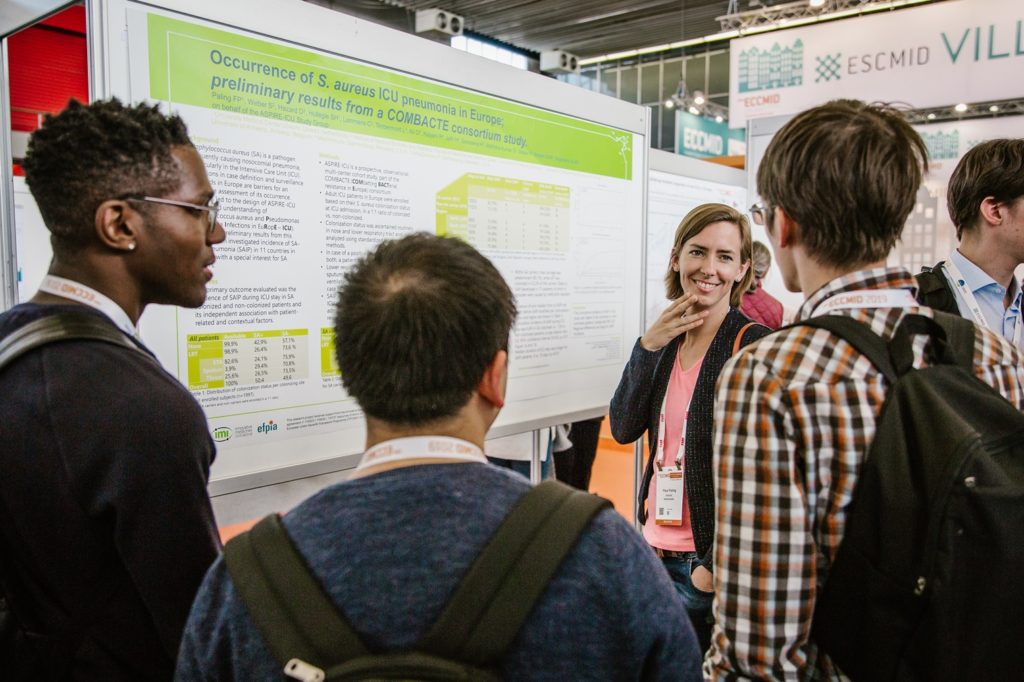Carriers of Staphylococcus aureus are at Increased Risk of Developing S aureus ICU-Acquired Pneumonia

MD Fleur Paling during the ASPIRE-ICU poster presentation at ECCMID 2019
The incidence of pneumonia due to infection with Staphylococcus aureus at the intensive care may be higher than previously thought, and future interventions to prevent this condition should focus on patients colonized with S. aureus to reduce pneumonia incidence, says Fleur Paling in her PhD research.
Fleur Paling is the coordinating investigator of COMBACTE-NET’s ASPIRE-ICU and has performed the primary analyses of the study. She has worked as a PhD candidate in infectious disease epidemiology under the supervision of Prof. Dr. Marc Bonten (UMC Utrecht) and Prof. Dr. Jan Kluytmans (UMC Utrecht). COMBACTE-NET’s ASPIRE-ICU was the backbone of her PhD trajectory, having finalized her thesis on ‘The role of carriage in the development of healthcare-associated infections with S. aureus and P. aeruginosa‘. The key findings of ASPIRE-ICU have just been published in JAMA Network Open.
Deep Dive
The Staphylococcus aureus bacterium is both a human commensal and an opportunistic pathogen. Approximately 25-30 percent of healthy people carry the bacterium on their skin or in their respiratory tract. At the same time, S. aureus is a true pathogen in disguise and has the potential to quickly manifest into a serious or even life-threatening infection. Carriers of S. aureus are known to have an increased risk of acquiring an S. aureus infection, especially in the critically ill, after surgery, when on renal dialysis and in people with a compromised immune system.
However, associations between S. aureus carriage and the development of S. aureus intensive care-acquired pneumonia (SAIP) have not been quantified accurately, and interpretation of available data is hampered due to variations in definitions. In order to get a deeper insight in SAIP, in 2015 Fleur Paling (Julius Center for Health Sciences and Primary Care, UMC Utrecht) and colleagues started the ASPIRE-ICU study to determine the incidence of SAIP in Europe, and which factors are associated with the risk of SAIP.
More pneumonia in carriers
The study consisted of 1.997 patients, of which 1.933 were used for the JAMA analysis. 950 of these were S. aureus carriers at ICU admission. In total, 304 patients developed ICU-acquired pneumonia, of whom 131 patients had SAIP. The overall incidence of SAIP was 4.9 events per 1000 patient-days at the ICU. There was a marked difference between colonized and non-colonized patients: SAIP incidences were 11.7 events per 1000 patient-days for S. aureus–colonized patients, compared to just 2.9 events per 1000 patient-days for non-colonized patients. Further analysis revealed that S. aureus colonization status remained the only factor that was independently associated with SAIP (hazard ratio 3.6; 95 percent CI 2.2-6.0; P<0.001).
“Our findings suggest that the incidence of pneumonia at the ICU due to S. aureus infection may be higher than initially perceived, and future interventions to prevent pneumonia at the ICU should focus on patients colonized with S. aureus” Fleur Paling concludes.
Fleur will defend her PhD thesis on October 20, 2020 at Utrecht University. She is finalizing her training to become a general practitioner at the end of 2020.
Related updates

The Last of COMBACTE: COMBACTE-NET

Important Pieces Of A Puzzle
